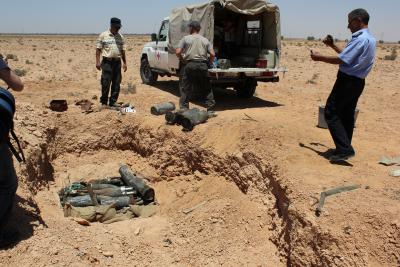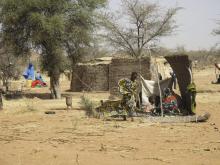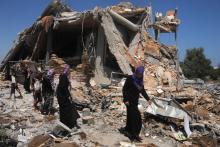Case prepared by Clara Delarue, Claudia Langianese, Giovanni Medici Tornaquinci, Eleanor Umeyor, LL.M. students at Roma Tre University under the supervision of Giulio Bartolini (IHL Professor), Tommaso Natoli and Alice Riccardi (Research assistants), Roma Tre University IHL Legal Clinic.
A. SECURING AMMUNITION IN LIBYA, A STEP TOWARDS IMPROVING PUBLIC SAFETY
Misrata- Building an ammunition shelter may not come across as a priority for many Libyans, who face the challenges of a post-revolution transitional period buffeted by political divisions, armed clashes as well as disruptions in the country's major lifeline in oil production.
But for the cities and towns where arms and ammunition are stashed in residential neighborhoods and in unsafe and unsecure environment, setting up a secure ammunition storage site by the United Nations and the Swiss Government matters, although it serves as an interim solution for an acute problem in a country awash with weapons and unsecured munitions from the 2011 conflict.
On 2 July, the first temporary ammunition shelter of its kind in post-revolutionary Libya was inaugurated in Misrata.
[…]
"We worked together with the United Nations Mine Action Service (UNMAS) team since March 2011, we managed to reduce the threat of Mines and Explosives Remnants of War (ERW) on the civilian population", stated Colonel Youssef Abdel Jawad, the representative of the Libyan Army Chief of General Staff office.
"The size of the problem is very big; it needs continuous efforts in order to remove the threat of Mines and ERW, as well as the unsecured ammunitions and weapons. We highly appreciate the support from the United Nations in this regards", he added.
"This ceremony is humble in its appearance but important in its significance, and sends a message to those responsible for rebuilding Libya of the importance of safeguarding its future," said Colonel Mohamed Terjuman from the Libyan Army Engineers and the responsible for Mine Action operations in Misrata.
With the civilian population's wellbeing a priority, the United Nations moved to assist the Libyans in the area of ammunition management, just as it is engaged in the form of offering training and advice in other security sector components as well as on the political, human rights, rule of law, transitional justice and public information levels.
"Our priority is public safety," Paul Heslop, Chief of Program Planning and Operations from UNMAS, New York, said in relevance to the inauguration of the temporary ammunition storage location in Misrata.
[…]
The $200,000 facility inaugurated in Misrata was built according to a template designed and constructed to international standards under Libyan and UN supervision and funded by the Swiss Government. The facility, split into two locations each capable of storing 200 tons of explosive materiel, features reinforced cement roofs and is encircled by a sand berm. Another facility is currently under construction under the supervision of the Army Chief of General Staff.
[…]
B. THE LIBYAN MINE ACTION CENTRE-LMAC
The Libyan Mine Action Centre (LMAC) was established in May 2011 by volunteer freedom fighters. Its urgent work was to clear mines and the explosive remnants of war in liberated areas. Dedicated volunteers worked to reduce risk, negotiate disputes, and encourage peace.
Throughout Libya, the population has organised themselves with pride and dignity, working to establish a free and peaceful Libya.
[…]
In December 2011, the Minister of Defence appointed an LMAC management board and LMAC was mandated by the first directive issued by that minister to manage all Mine Action activities in Libya, and also manage a Technical Agreement with outside governments to secure Ammunition Storage Areas (ASAs) around the country.
Since that time, LMAC has been actively supporting Libyan efforts, including the significant achievements of the Libyan army. LMAC has also been assisting with the ASA programme and helping the international Mine Action NGOs working in Libya whenever possible.
C. TOGETHER FOR A LIBYA FREE OF MINES AND EXPLOSIVE REMNANTS
[…]
Lance Malin, Chief of UNMAS Libya said " It has been our privilege to work closely with the Libyan Mine Action Centre (LibMAC) and other implementing partners over the last few years to assist Libya to address the deadly impact of mines and explosive remnants of war. We continue to work remotely from Tunisia as we strive to assist the Libyan people in the priority tasks of surveying and clearance of these items, education about the risks associated with ERW and of small arms light weapons (SALW) and in the support of injured victims and their families. We look forward to returning to Libya soon to be able to work face to face with our partners and other stakeholders in moving Libya towards a safer future without explosive hazards."
D. LMAS-LIBYAN MINE ACTION STANDARDS
[Source: Libyan Ministry of Defence, Libyan Mine Action Centre, January 2012, available at: Link not available.]
[…]
4. Purpose of LMAS
LMAS have been developed to improve safety, efficiency and effectiveness in mine action and to promote a common and consistent approach to the conduct of mine action operations in Libya. LMAS provide guidance, establish principles and, in some cases, define strict requirements and specifications. They provide a frame of reference which encourages the sponsors and managers of mine action programmes and projects to achieve and demonstrate appropriate levels of effectiveness and safety. The LMAS also provide rules which enable the accurate and timely exchange of important information.
5. Guiding principles
The preparation and application of LMAS are shaped by four guiding principles:
1. the right of the Libyan national government to apply national standards to its national programme;
2. LMAS should protect those most at risk;
3. LMAS should be part of a national capacity able to maintain and apply appropriate standards for mine action; and
4. LMAS should, whenever appropriate, be consistent with other international norms and standards.
6. National responsibilities
The primary responsibility for Libyan mine action lies with the Government of Libya. This responsibility is vested in a Libyan Mine Action Centre (a part of the Libyan Ministry of Defence) which is charged with developing mine action policy and with overseeing its implementation. The Libyan Mine Action Centre (LMAC) is charged with the regulation, management and coordination of the national mine action programme. The LMAC is responsible for establishing the national and local conditions which enable the effective management of mine action
7. Humanitarian imperative
Landmines and ERW are a humanitarian concern and should be addressed from the humanitarian perspective. These standards respect fundamental humanitarian principles of impartiality and humanity. Humanitarian mine action should be concerned to give support to those who are most vulnerable, and must be conducted in a manner that does not expose staff to unnecessary risk.
[…]
E. LIBYA- MINE BAN POLICY
The State of Libya has not acceded to the Mine Ban Treaty. Government officials did not make any statements in 2014 or the first half of 2015 on the question of Libya joining.
Previously, in October 2011, two Ministry of Foreign Affairs officials informed the ICBL [International Campaign to Ban Landmines] that there was support for joining the Mine Ban Treaty, but the matter must wait until the new government is established and for the legislative body to consider accession. Libya’s signature of the 2013 Arms Trade Treaty on 9 July 2013 indicates that the government is ready to join international treaties.
On 2 December 2014, Libya voted for UN General Assembly (UNGA) Resolution 69/34 supporting universalization and implementation of the Mine Ban Treaty. This was the second year that Libya had voted in favor of the pro-Mine Ban Treaty resolution, after consistently abstaining from the annual resolution since 1998. The change came after outreach by the ICBL, including Human Rights Watch (HRW).
Prior to being removed from office in 2011, the government of Muammar Gaddafi showed interest in the Mine Ban Treaty but made no effort to join it; Libyan officials often criticized the treaty and called for it to be revised. On 28 April 2011, the National Transitional Council (NTC), then the opposition authority in Libya, issued a statement formally pledging that “no forces under the command and control of the [NTC] will use antipersonnel or anti-vehicle landmines.” The statement also said that “any future Libyan government should relinquish landmines and join the 1997 Mine Ban Treaty.”
Despite not joining the Mine Ban Treaty, Libya has participated as an observer in many of the treaty’s Meeting of States Parties as well as the first and third Review Conferences. Libya did not make any statements at the Thirteenth Meeting of States Parties in Geneva in December 2013 or the Third Review Conference in June 2014. It has also regularly attended intersessional Standing Committee meetings of the treaty in Geneva, including in June 2015.
[…]
Discussion
I. Classification of the Situation and Applicable Law
1. How would you classify the situation in Libya in May 2011 and onwards? What additional information would you need in order to make such a determination? (
GC I-IV, Arts 2,
3; P II, Art. 1).
2. Does the classification of the situation matter for determining whether IHL was respected in this case?
II. Demining Action
4. Has Libya ratified relevant treaties dealing with mines and explosive remnants of war? Are some of the measures described above also required by customary law? (
CIHL, Rules 81,
82 and
83)
III. Elements contributing to respect for IHL
6. (Document A) According to the words of the Colonel Mohamed Terjuman, why is the ceremony “important to send a message to those responsible for rebuilding Libya of the importance of safeguarding its future"? To what extent may a better respect for the mine ban facilitate return to peace in the country?
7. Can the institutions such as the UN Mine Action Service (UNMAS) and the United Nations Support Mission for Libya (UNSMIL) play a positive role in the implementation of mine action programs? How?
8. (Document E) In your opinion, can the influence of third States and international and regional organisations have a positive impact on the decision of a State to become parties to IHL treaties?






